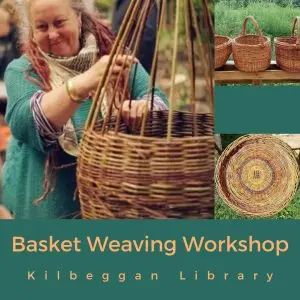Article by Caroline Barry
Kilbeggan Library is delighted to announce that Westcountry Willows will be hosting a Basket Making workshop in the library on August 15th, 12pm-4pm to celebrate Heritage Week. - Please note this event is now booked out.
Workshops funded by Westmeath's Heritage Office for Heritage Week 2023.

The variety of form and functional use of traditional wickerwork or basketmaking in Ireland is enormous. The craft of wickerwork is ancient, and the discovery of baskets buried in bogs in Westmeath and Tipperary has been reliably dated to neolithic times. Ancient basket makers skills were frequently used in construction, for example late bronze age wickerwork has been found in ancient crannogs, and functioning as a support for mortar in castle roofs or used as the skeletal structure of partition walls in old houses. Evidence of medieval wickerwork has been found in fences, walls of houses, pathways, floormats and wicker doors. The most common use of wickerwork is of course, baskets.
The material most basket makers use in Ireland is ‘sally’ from the gaelic ‘sáileach’. Sally has been cultivated for the sole purpose of producing baskets and at one time sally gardens were a common feature of rural Ireland, as is immortalized in the song, ‘Down by the sally gardens.’
The greatest range of shape, size and form in baskets can be seen in household containers with each region of Ireland having it’s own idiosyncratic preference. You have the common basket used around the house called the skib, made from peeled, unpeeled or red and white rods. In Donegal they called this basket the báscaid geal, in County Galway it was called a ciseog, everywhere else they called it the potato ‘teeming’ basket. This basket was used to drain the water off boiled potatoes and according to researcher and author Anne O’Dowd, ‘the basket laden with steaming potatoes was placed over a pot of boiling water in the centre of the floor and the family sat around and ate their meal.’
There were baskets of all kinds, baskets for carrying turf, for catching fish, for storing food, for bringing in laundry or making traps to catch wild animals, shopping baskets and cradles, yeast baskets to transport yeast, and hampers for transporting fowl.
By the 1980’s the traditional basket makers were few and far between. Thankfully in recent years there has been a revival of interest in this traditional craft, with people really appreciating the variety of beautiful handmade baskets made of natural, organic materials and glowing with dull autumnal colours. Westcountry willows will show participants how to make a beginners-willow basket, reviving a tradition that was at risk of disappearing.
To keep up to date with all library events click here, or follow us on social media : Facebook, Twitter, Instagram, or TikTok.
If this workshop inspires you to find out more about willow weaving or traditional crafts why not take a look at these two books